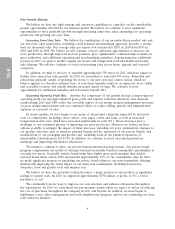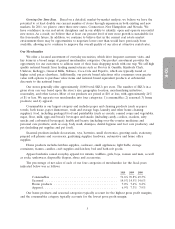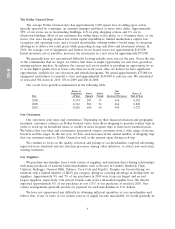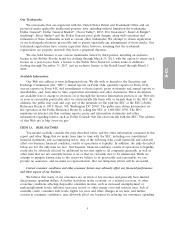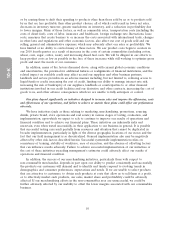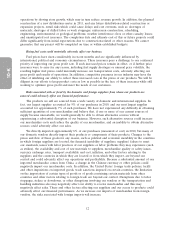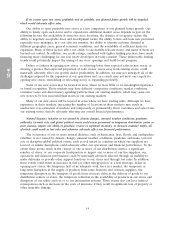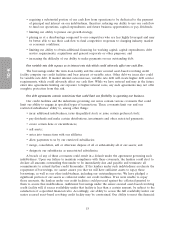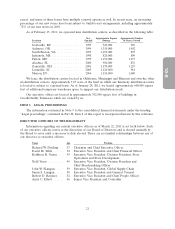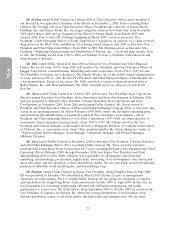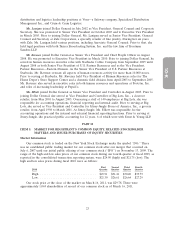Dollar General 2010 Annual Report Download - page 92
Download and view the complete annual report
Please find page 92 of the 2010 Dollar General annual report below. You can navigate through the pages in the report by either clicking on the pages listed below, or by using the keyword search tool below to find specific information within the annual report.
10-K
If we cannot open new stores profitably and on schedule, our planned future growth will be impeded,
which would adversely affect sales.
Our ability to open profitable new stores is a key component of our planned future growth. Our
ability to timely open such stores and to expand into additional market areas depends in part on the
following factors: the availability of attractive store locations; the absence of occupancy delays; the
ability to negotiate acceptable lease and development terms; the ability to hire and train new personnel,
especially store managers, in a cost effective manner; the ability to identify customer demand in
different geographic areas; general economic conditions; and the availability of sufficient funds for
expansion. Many of these factors affect our ability to successfully relocate stores, and many of them are
beyond our control. In addition, our credit ratings, combined with tighter lending practices, have made
financing more challenging for our real estate developers in today’s market. These unfavorable lending
trends could potentially impact the timing of our store openings and build-to-suit program.
Delays or failures in opening new stores, or achieving lower than expected sales in new stores, or
drawing a greater than expected proportion of sales in new stores away from existing stores, could
materially adversely affect our growth and/or profitability. In addition, we may not anticipate all of the
challenges imposed by the expansion of our operations and, as a result, may not meet our targets for
opening new stores, remodeling or relocating stores or expanding profitably.
Some of our new stores may be located in areas where we have little or no meaningful experience
or brand recognition. Those markets may have different competitive conditions, market conditions,
consumer tastes and discretionary spending patterns than our existing markets, which may cause our
new stores to be less successful than stores in our existing markets.
Many of our new stores will be located in areas where we have existing units. Although we have
experience in these markets, increasing the number of locations in these markets may result in
inadvertent over-saturation of markets and temporarily or permanently divert customers and sales from
our existing stores, thereby adversely affecting our overall financial performance.
Natural disasters (whether or not caused by climate change), unusual weather conditions, pandemic
outbreaks, terrorist acts, and global political events could cause permanent or temporary distribution center or
store closures, impair our ability to purchase, receive or replenish inventory, or decrease customer traffic, all
of which could result in lost sales and otherwise adversely affect our financial performance.
The occurrence of one or more natural disasters, such as hurricanes, fires, floods, and earthquakes
(whether or not caused by climate change), unusual weather conditions, pandemic outbreaks, terrorist
acts or disruptive global political events, such as civil unrest in countries in which our suppliers are
located, or similar disruptions could adversely affect our operations and financial performance. To the
extent these events result in the closure of one or more of our distribution centers, a significant
number of stores, or our corporate headquarters or impact one or more of our key suppliers, our
operations and financial performance could be materially adversely affected through an inability to
make deliveries or provide other support functions to our stores and through lost sales. In addition,
these events could result in increases in fuel (or other energy) prices or a fuel shortage, delays in
opening new stores, the temporary lack of an adequate work force in a market, the temporary or
long-term disruption in the supply of products from some domestic and overseas suppliers, the
temporary disruption in the transport of goods from overseas, delay in the delivery of goods to our
distribution centers or stores, the temporary reduction in the availability of products in our stores and
disruption of our utility services or to our information systems. These events also can have indirect
consequences such as increases in the costs of insurance if they result in significant loss of property or
other insurable damage.
14


